Saint Emilion Sensations 2018
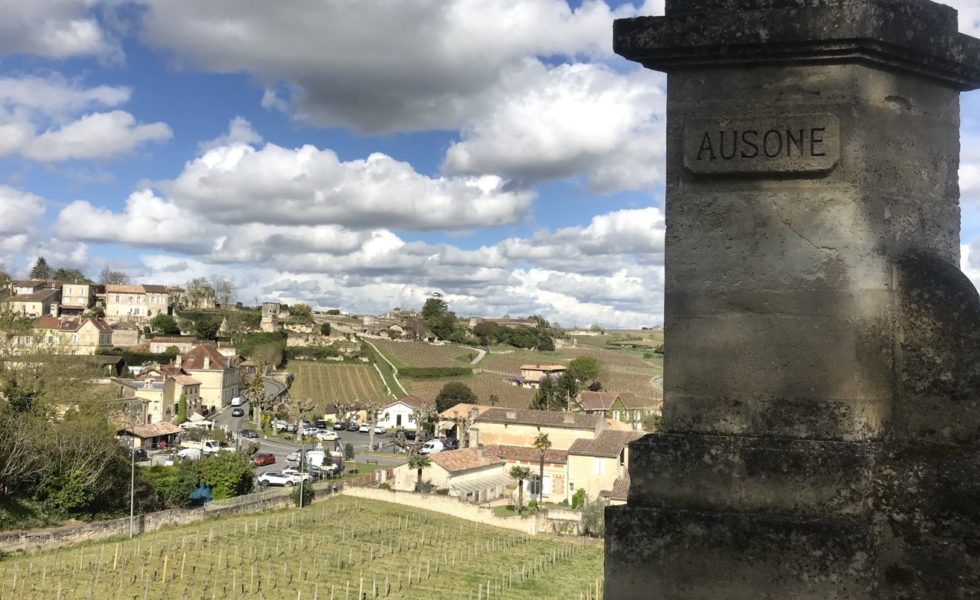
Change in style continues: Yahoo!
by Panos Kakaviatos for wine-chronicles.com
26 April 2019
Very happy to see how much the “refreshing trend” is coming into focus in Saint Emilion. As stated in my introduction to the vintage, with regard to the 50 member estates of the Association of Saint Emilion Grands Crus Classés. Here we have a case of many 2018s tasting better than their 2016 counterparts.
Late last year, I tasted these same wines, but from the recently bottled 2016 vintage. Too often, the extractions were more noticeable in the 2016s, and the tasting experience less positive.
Of course the cooler vintage character of 2016 mitigated winemaking more than a vintage like 2009 did. But 2016 was a let down from too many of these estates. So with some exceptions, 2018 proves that you don’t get what you expect, and here this is a plus.
At the press tastings of the UGCB, Bloomberg wine writer and author Elin McCoy and I looked at each other with surprise after tasting Château La Couspaude, a wine long known for excessively oaky flavors.
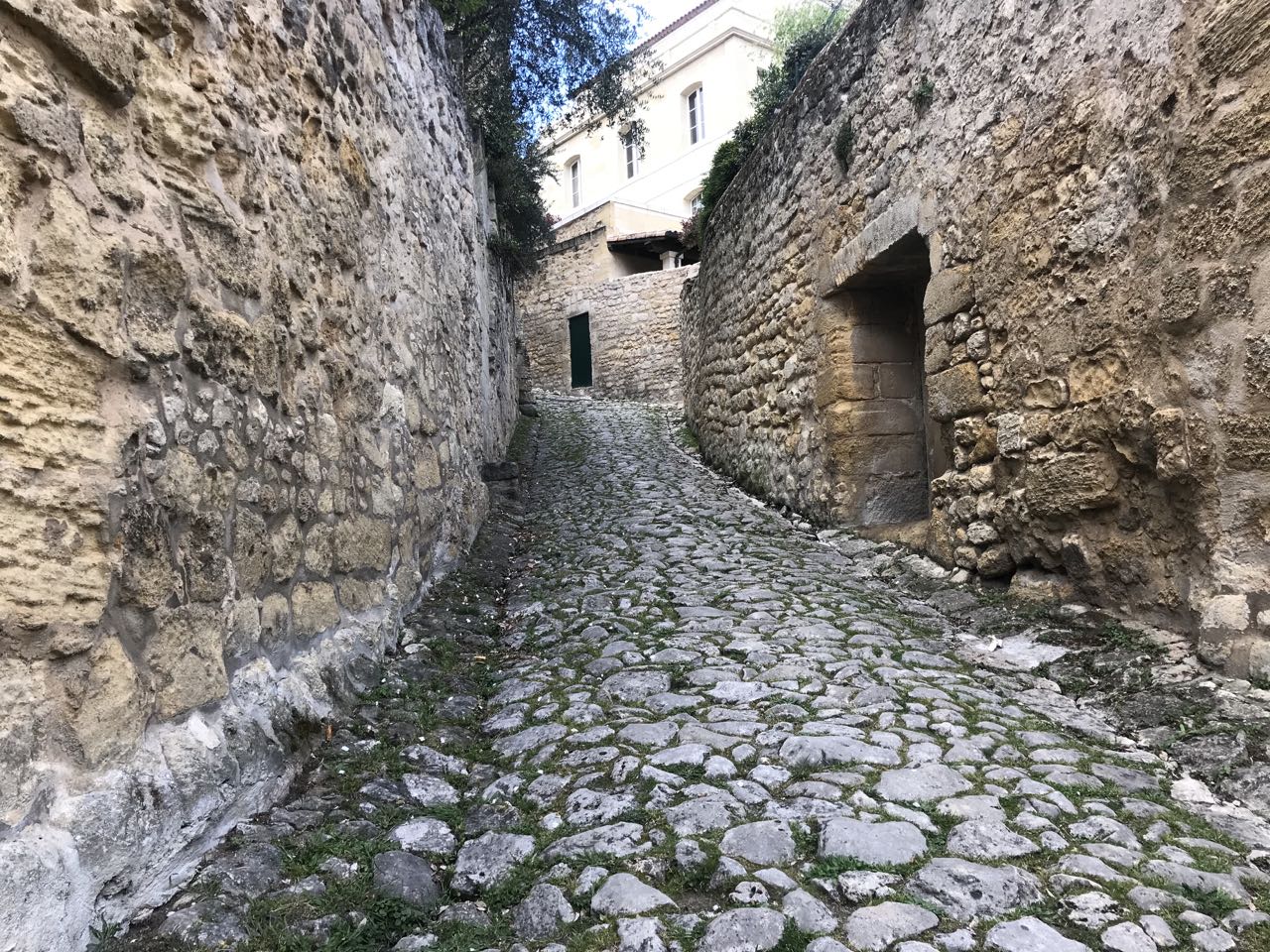
Saint Emilion: taking a charming path towards more freshness
We just marveled at how much better it was than we were expecting.
My overall impression, especially of Saint Emilion? Strangely enough, I found myself wondering about how many critics reacted to the 1982 back in 1983. Many critics who had tasted the 1982 from barrel found it “too easy to taste” or too soft for long-term aging. Sure, that was another era, as winemaking and viticulture were different, and 2018 has more alcohol and more tannin. So I am not saying that the 2018 vintage is like the 1982 in terms of tannin, alcohol, and overall sensation. But what I am saying is that any naysayers for Saint Emilion in 2018 may be under-estimating the vintage. Many 2018s have smooth and even silky tannins and freshness, as well as tannin and structure. Here is another comparison, with the specific estate of Château Grand Mayne. Their 1998 remains one of the best ever that I have tasted. In the bigger alcohol, bigger extraction era of the mid to late 2000s, it was not as easy or pleasurable to taste. But since at least 2014, I have been enjoying Grand Mayne quite a bit. And 2018 is no exception.
Tasting notes
Some barrel samples I tasted twice, whether at the aforementioned Grand Cru Classé Association tasting, at the negociant Joanne or at the UGCB. As for the Premiers Grands Crus Classés, I did not get to all of them, as my time in Bordeaux was limited. I wish they could resuscitate the Association des Premiers Grands Crus Classés, so it would be easier to taste most of them in one location. Anyway, top wines below DO NOT include Angélus, Beausejour Duffau Lagarrosse, Canon, Pavie or Tertre Roteboeuf, but these notes will updated as and when I get a chance to assess the above missing wines.
For now, my top list of Saint Emilion includes Ausone and Cheval Blanc to be sure, but also Figeac,
As usual, if bold, I liked in particular. If red and bold, even more. If underlined, too, a potential nirvana wine.
Château Ausone – Almost Médoc in approach, with cool fruit and graphite, and my goodness such precision. Such freshness and seriousness, conjuring images of a polished and elegant Hermes suit, as you can see in my above video (No, I am not wearing Hermes or likely buying Ausone, but it really is a great wine). Pure fruit, and focus – and a delectably juicy mid palate, with fine balancing acidity make this wine utterly gorgeous. The limestone really helped to retain freshness here. “We always have a pH of about 3.6,” remarked co-owner Paulette Vauthier. Again, I do not want to get too obsessed with “the numbers” but I like very much the type of balance here, both aromatically and texturally. 97-100
Château Balestard La Tonnelle – I like the nose. There is oak, sure, but more “Bordeaux” typicity than in previous years. Alas, the palate is not as interesting, as it dries out a bit. 88-90
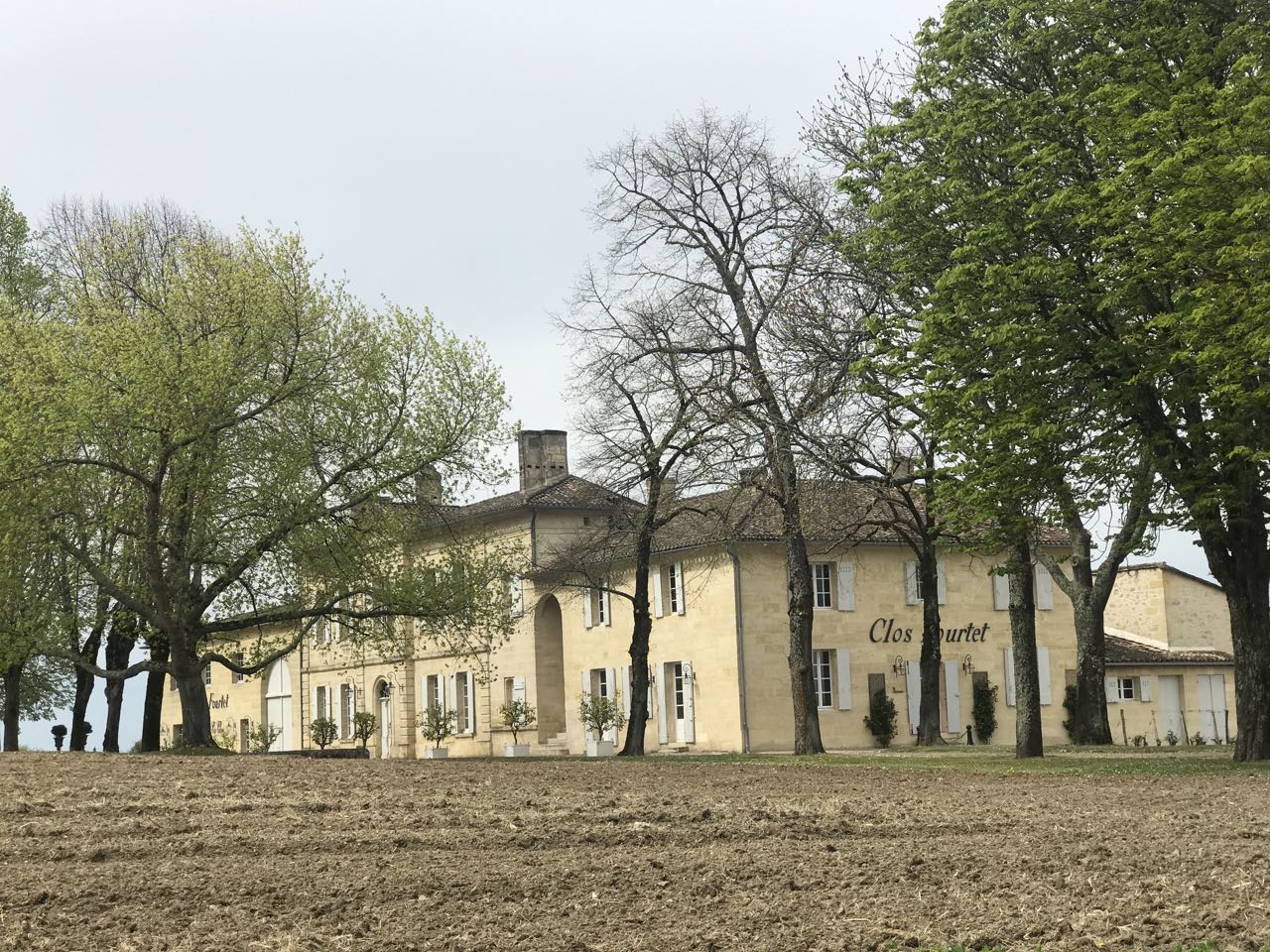
Close up, Clos Fourtet
Château Belair Monange – Nose is somewhat reticent at first. But as you try it over time, this turns into a svelte wine of freshness, and the nose has discernible fresh aspects. Lovely balance of richness and elegance overall. Nice! There is contour to this wine and subtlety. It was hard to appreciate just after tasting Château Trotanoy, as required by the Moueix in their Libourne offices. One has to step back and appreciate the limestone freshness from this terroir to realize that this is a most excellent vintage! 94-96+
Château Bellefont Belcier – This was so smooth and appealing, and with no rough edges. While lacking the depth of the top wines among Saint Emilion, I like the ripe red and dark fruit, the nuanced palate, and a fresh finish. Bravo! 91-93
Château Beau-Séjour Bécot – This blend of 80% Merlot, 15% Cabernet Franc and the rest Cabernet Sauvignon was cropped at 46 hectoliters per hectare and is aging in less new oak than usual (60%), thanks to the sound advice of rising star wine consultant Thomas Duclos. The wine tastes fresher than usual, and deserves to be on the Liv-Ex list of top value wines of the 2018 vintage. Give credit to Michel Rolland actually for already a soft pedal in 2016, a vintage that shines bright as well here! But with Duclos, we go full (soft) Monty. Malolactic is no longer carried out in new oak, but rather in stainless steel, so that that glossy modern sheen that sometimes annoyed me here is gone. It helps that the wine is aging in 20% amphorae, which is a growing trend as well in Bordeaux (see also La Conseillante). So in short, elegance with tannic bite: a wine that has the richness, too, of Merlot, but staying power. Nice job! 92-95
Château Canon La Gaffeliere – OK you do get some jammy fruit on the nose … The palate is somewhat “thickly laid out”, and here an example where I prefer the 2016! Having written this, this estate is better than some of the others whose oak and drying aspects (Franc Mayne, Balestard) are less appealing. Of course owner Stephan Von Neipperg has a Midas touch, so I think this will turn out to be quite good indeed, from bottle. 92-94
Château Chauvin – With 13 hectares, this estate is planted with 75% Merlot. Fruit driven aromatics, more red than dark fruit. Like the others at the Association des Grands Crus Classés, an overall smooth sense, but here an austerity kicks in later as palate is somewhat tight. A bit austere on the finish, but that should smoothen out with barrel aging. 90-92
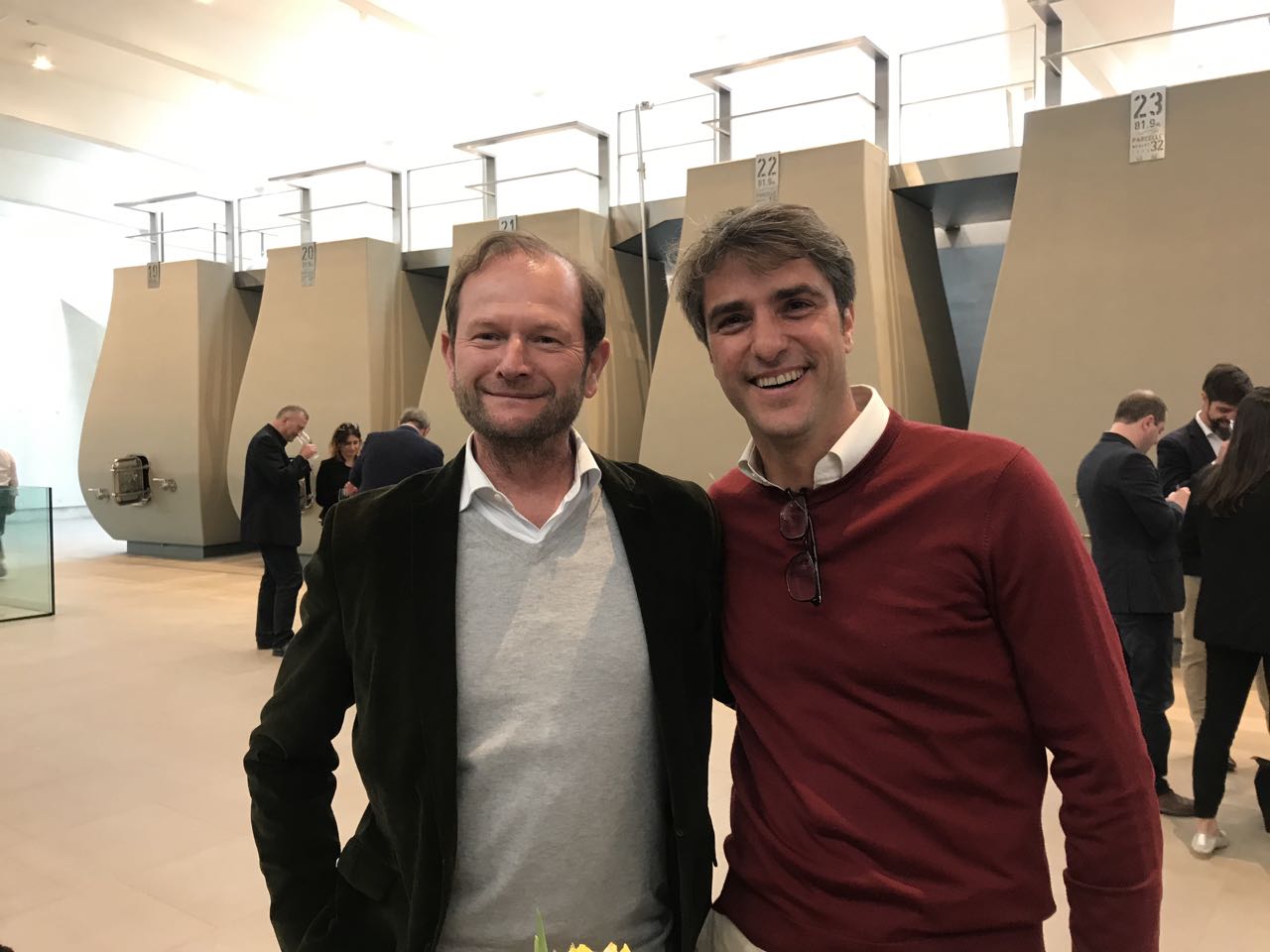
Pierre Lurton and Pierre Olivier Clouet (at right) of Château Cheval Blanc. They can smile for the best wine I tasted from barrel among all in Saint Emilion in 2018.
Château Cheval Blanc* – So far, the best of all the Saint Emilion wines that I tried en primeur in 2018. Sumptuously floral and fresh. A wine of both elegance and (near) decadence. “The densest wine we have made since 2011”, remarked director Pierre Olivier Clouet. The blend of 54% Merlot, 40% Cabernet Franc and 6% Cabernet Sauvignon has enough acidity for balance. “Early picking helps to maintain that,” he said. Fine freshness and opulence, with black fruit and floral notes, leading to fresh mint and licorice on the lifting, long finish. “The balance comes from (higher) yields”, says Clouet, comparing the 2018 to the Cheval 1990 and 1998, but the 1990 especially makes me think of the 2018. BRAVO! 98-100
Château Clos Fourtet – Aromas somewhat oak driven but the palate is much better. This is quite tasty indeed. Cooler exposure suited the 2018 vintage, and the limestone plateau ensured freshness: in short, a lovely red! 93-95
Château La Couspaude – Tar like nose. The palate is not as bad as I was expecting. Are they dialing back on new oak? There is ripe fruit and not a drying finish! Nice!! I mean, it does not impress me nearly as much as, say, La Dominique, but still … Tasted both at the UGCB and at the Association of Grands Crus Classés, where the oak was a bit more discernible, but this seven-hectare terroir with 20% Cabernet Franc (and 5% Cabernet Sauvignon) is better than expected indeed. Bravo! 90-92
Château Couvent Jacobins – Has grip but a bit of reduction, so the aromatics are just a bit closed in. I like the ripe fruit and medium body. There is structure to the wine which also is a good thing. 90-92+
Château Corbin – Has glycerin to be sure. A sweet nose, but with mint, too. The palate is rich and flavorful, with some heady aspects. Overall a rather sumptuous expression, à la 2015. Nice job, but I am not surprised as this estate is quite consistent indeed for good quality. 92-94
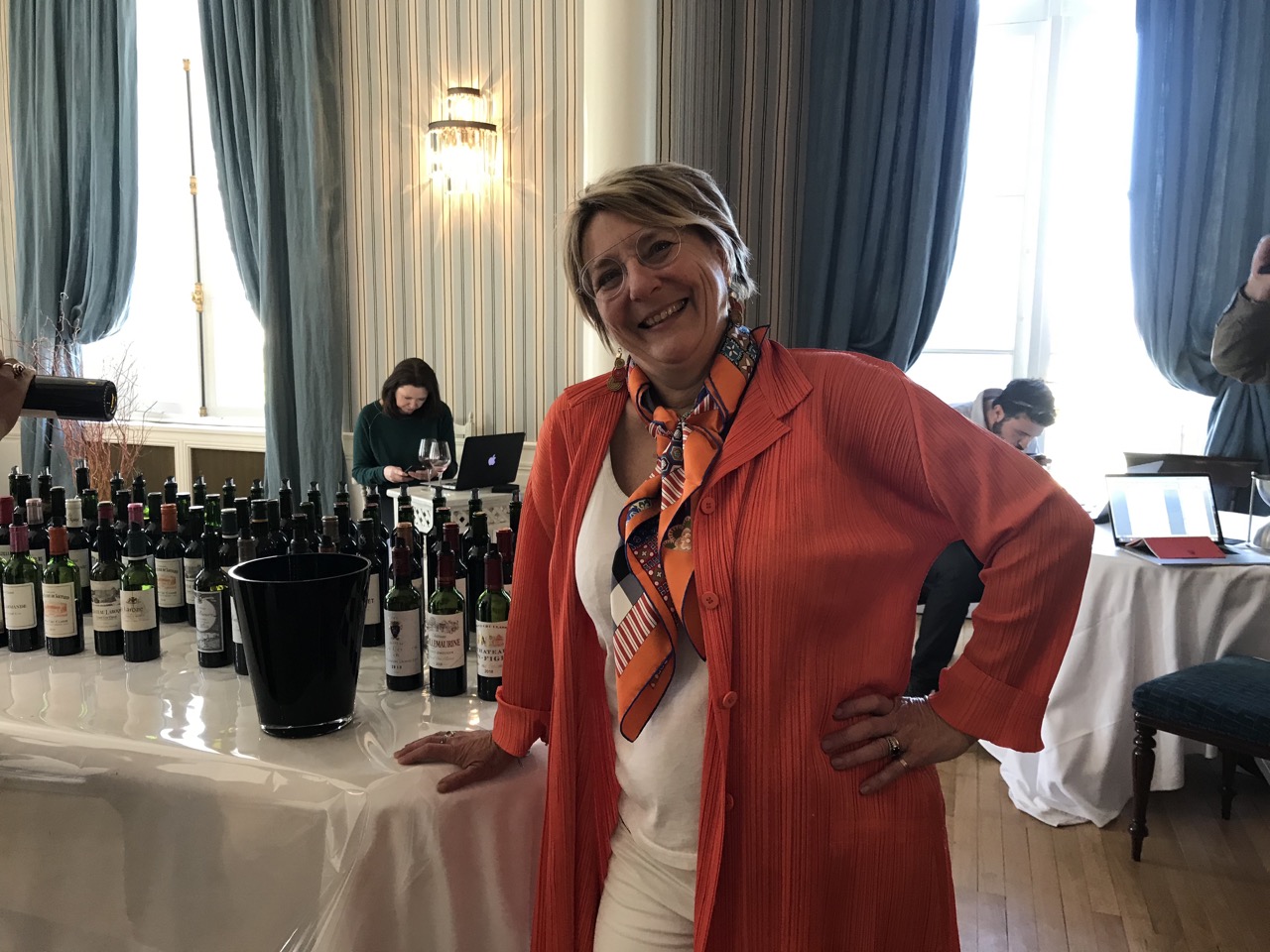
Hostess with the mostess: Laurence Brun of Château Dassault, which hosted the press tasting of 50 estates making up the association of Saint Emilion Grands Crus Classés.
Château Dassault – Jammy fruit here, but certainly agreeable. There is Merlot but with the Welcome Mat of “sans any excessive extraction or drying oak”. Nice. Tasted both at the estate and at the UGCB. The jammy aspects are undeniable. Some oak driven tannin too, but smooth and not drying. The best Dassault in a long while from barrel. Bravo! 91-93
Château Destieux – Sweet aromas and somewhat oak driven on the palate here. Tannins are a tad hard? Not sure about this one. One of the few at the Association of Grands Crus Classés that reminded me of the more challenging 2016 tasting… There is mid palate sap and concentration to be sure. And maybe barrel aging will resolve this. 89-91
Château La Dominique – While the nose seems a bit closed in, this may be the best in a while from primeur! I love the mid palate sap here, with nuanced aspects of ripe fruit and layered texture leading to a fresh finish. Bravo! 92-94+
Château Franc Mayne – Here we have some oak influence overriding the fruit on the nose. The palate is better, as there is juice, but just not as clearly delineated as in Clos Fourtet or La Dominique, tasted just before at the UGCB. 90-92
Château Grand Corbin – This is tasty enough, and again, it has a smoothness to it that appeals. Somewhat short on the finish? Certainly a bit more tannic edge to this, so let us especially see how it tastes from bottle. 90-92
Château Grand Corbin d’Espagne – Similar size as above but more Cabernet Franc, at 24%. The palate is quite smooth and rather elegant although, again, there is an aspect, a hint, of some soupy aspects here. I may be getting nitpicky, but this is high end Bordeaux, so let’s be serious! 90-92
Château Grand Mayne – Rich and ripe nose of black fruit. Reminds me of the 2015 to some extent. Flavorful and rich and sap driven, and – again – the estate is dialing back on extractions so that the drying of, say, 2005 or 2009 is gone. Lovely wine! 92-95
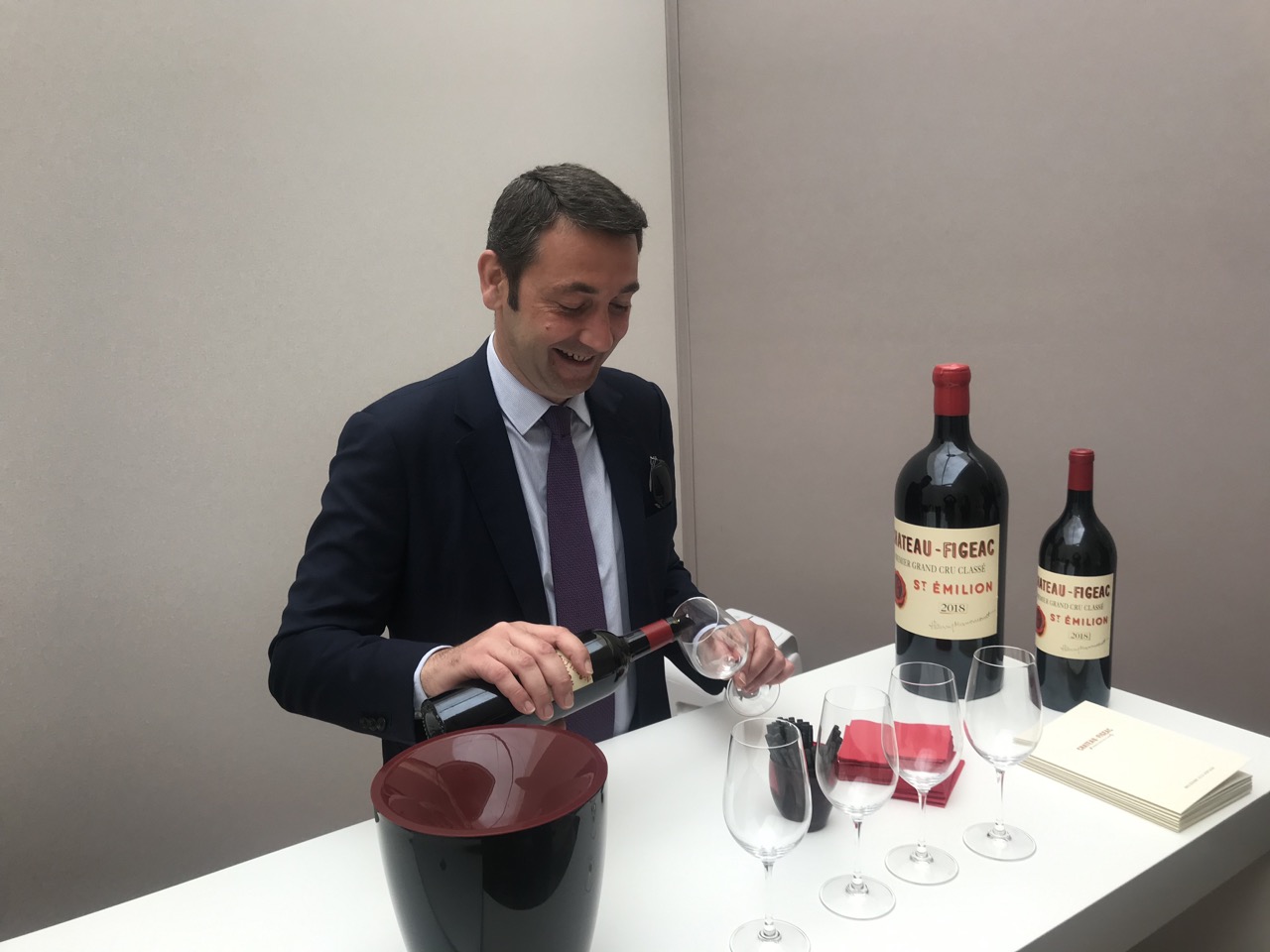
Château Figeac director Frederic Faye understandably happy with the 2018 vintage.
Château Figeac – Tasted with director Frederic Faye and a great success for this venerable estate. The Cabernets certainly profited from the hot and dry summer and harvest period. But the pips were already brown by the end of August, something that Faye had “never seen before” as the “grape skins were not ripe” he added. So it is interesting to note that the sun did not “grill the skins”, and that it was more the dryness that created thick skins, but pips getting ripe beforehand. Indeed, Faye stressed that dry wind in October meant evaporation and concentration, which accentuated the thicker skins of the grapes. One of the main challenges was to have opulence, but to maintain freshness. Picking was thus partly “Al Dente.” as Faye explained that you needed to pick when the bunches were ready and manage that in the cellar and be gentle with the extraction. So how is this blend of 37% Merlot, 33% Cabernet Sauvignon and the rest Cabernet Franc? Well, there is charm here and richness with fine ripeness. The balance of 3.7 pH and 14.1% alcohol appeals to me. And 30% of the crop went into the second wine. In short, this is great wine, with the Cabernets playing a favor for the Saint Emilion. The alcohol is not really noticeable: it is there, to be sure, but there is density and elegance too. A very successful Figeac. This has a lovely mint freshness, crushed mint. I am just not sure if it is necessarily better than, say, 2015 or even 2016. Cropped at 39 hectoliters per hectare. 95-97
Château Faugeres – A rather large estate with 37 hectares of vines, and 10 percent Cabernet France and 5% Cabernet Sauvignon for added structure. Deep aromas of violet and dark, fruit ripe. Very ripe plums on the palate, with smooth tannin and, well, delicious. What is not to like? My goodness, this may well be a hit. Fine tannin and structure on the finish. 92-95
Château Fleur Cardinale – Planted to 75% Merlot, 25% Cabernet Franc and 5% Cabernet Sauvignon, this wine comes from a vineyard of 23.5 hectares. Deep violet color, and the nose is also dark fruit, preceded by a smooth tannin palate, a bit of “gloss”, perhaps, but overall fitting into that warm and huggy (not fuzzy) Saint Emilion feeling in 2018! Nice job! 92-94+
Château Fombrauge – At 89% Merlot, this wine is not too heady; at least I do not “get the ether” here, and there is interest on the palate, with a certain grip, too. There is tannin edge to this wine, too. Let’s see how it tastes from bottle, but it is pretty darn good from barrel. 91-93
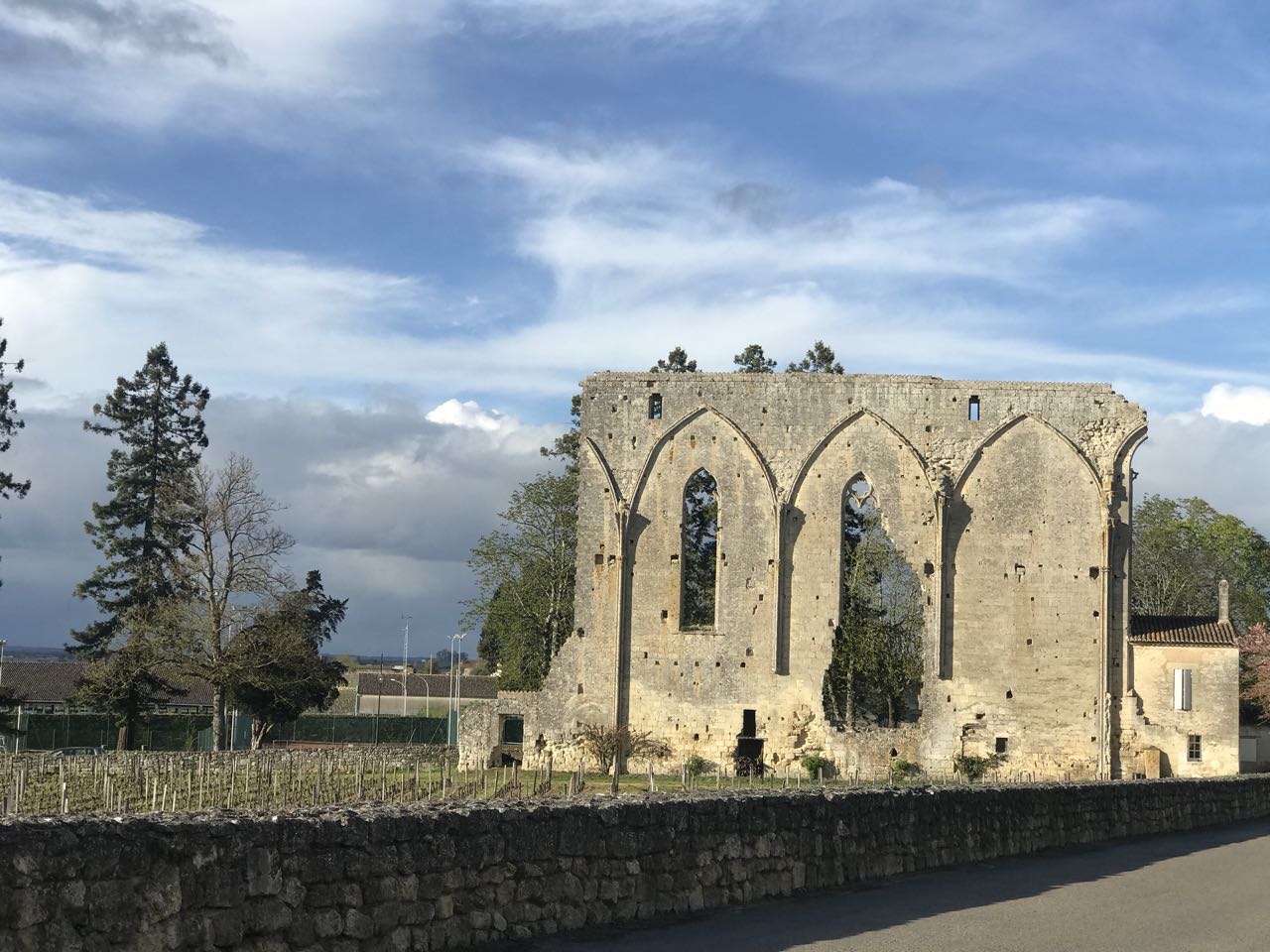
Not only are the wines lovely in 2018, but the town of Saint Emilion is just gorgeous.
Château Fonroque – I like the freshness as well as grip. More than most at the tasting of the Grands Crus Classés, this one shows a bit more power and some tannic oomph. There is grip to be sure, albeit a hint of drying on the finish. 91-93
Château Godeau – I like the mid palate juiciness, but it comes down somewhat hard on the finish, somewhat austere. Let’s see how it does from bottle! 89-91
Château Laroze – Like others, the sample was drawn two days earlier, on 28 March, no doubt to soften the tannin. Planted in 27 hectares with 28% Cabernet Franc and 8% Cabernet Sauvignon. This barrel sample exhibits pleasing, primary fruit aromas, some oak as well, but the palate conveys richness and depth, albeit just a touch hard on the finish. Overall, fine tannins. 90-92
Château Laroque – Some floral notes here but also evident oak derivation. But not excessive. The tannins are soft and ripe, and the overall experience is almost relaxed. There is some ether felt but the dry extract is excellent, and the sense is of a wine that is warm and fuzzy without being soupy. Let’s see how it ages! 90-92
Château Larcis Ducasse – Even if the nose is somewhat closed here, with time in glass, it displays more charm indeed. I like the palate here indeed, which comes across very smooth and limestone fresh. With time in glass the underlying density shows itself. This barrel sample is easily be one of the best ever that I have tasted from this estate. 94-96
Château Larmande – With 32% Cabernet Franc, this is quite nice, too, but not as bright as the next wine. Soft and elegant and warm. What is not to like? But it does kind of remind me of a soupy style… 90-92
Château Lynsolence – Too oaky for me. Maybe in a few years things will settle, but I am not convinced. There is mid palate sap to be sure, but the finish dries out too much for mon goût.
Château Magrez Fombrauge – Tasted at the excellent Grand Cercle gathering, the barrel sample seemed too heavy and somewhat alcoholic. I prefer the regular cuvée (see above). And, besides, the bottle is not Umweltfreundlich (that’s German; look it up).
Château Pavie Macquin – Assessed as part of the very well organized press tastings of the UGCB, what fine expression, again, showing off a change in style. The wine breaths refinement and elegance, and the underlying tannic structure will fill out once in bottle. I look very much forward to tasting this from bottle! 92-95
Château Le Prieuré – About 6.4 hectares with 20% Cabernet Franc. I like the nose here, as it shows some fresh mint aspects, from ripe Cabernet Franc no doubt. Some elegance, albeit a touch of warmth on the finish, but that is expected from this vintage. What is not expected is the elegance indeed. Nice. 89-92
Château Petite Faurie de Soutard – This has 30 Cabernet Franc, and 8 hectares. Yet another approachable wine from Saint Emilion in 2018, as wine author and noted Bordeaux critic Jane Anson pointed out during the tasting. Bravo! 91-93
Château Pindefleurs – This has a pleasingly spicy aspect aromatically, as compared to the Puy-Blanquet, both tasted at the Moueix offices in Libourne. Could it be the oak? I like the overall sense, here, although maybe not as supple on the palate as the the Puy-Blanquet, which I prefer. 90-92
Château Puy-Blanquet – Fine ground chocolate aroma. Good grip, round and supple. There is real appeal here, with supple tannins and a smooth finish. 91-93
Château de Pressac – A whopping 36 hectares of prime terroir! The estate takes advantage, too, of the 17% Cabernet Franc and 9% Cabernet Sauvignon planted. The 2018 exhibits a lovely nose, rather fresh, floral and fruit driven. Perhaps the best that I can recall tasting en primeur. There is a touch of that oak derivation on the finish, but not as pronounced as in other vintages. And the alcohol is well integrated. Overall quite smooth. Nice! 92-95
Château Rochebelle – Just three hectares of vines. Comes across rather jammy and with sweet jam aromas. The palate shows grip however, perhaps that limestone terroir helps indeed, better palate. Still, you can feel a bit of heat, here, on the finish. 90-92
Château Rol Valentin – The palate is warm and enveloping, but not with any overtly drying out oak staves. Not bad! 90-92
Château Sansonnet – This estate has seven hectares, nicely situated with limestone, planted also with some Cabernet Sauvignon, which lends structure to the 2018. Dark fruit aspects, dark color. The palate is powerful, but contained. The terroir shines through, although perhaps just a touch stolid in expression at this barrel stage? In any case, a serious wine. The finish is not heavy. Indeed, the overall impression is one of smooth tannin. 91-93
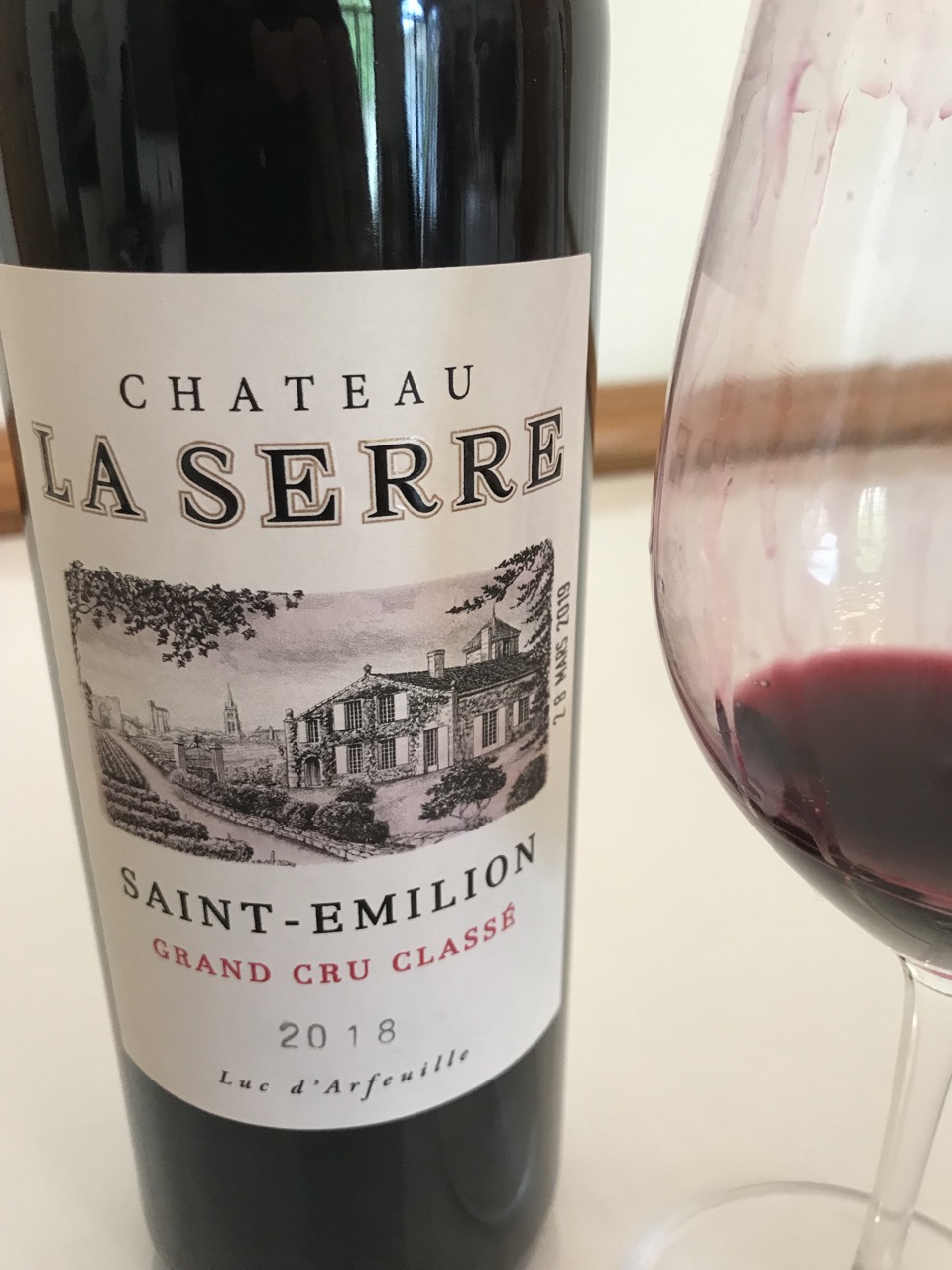
Bargain alert!
Château La Serre – Bargain alert! This seven hectares vineyard plants to 80% Merlot and 20% Cabernet Franc excelled in 2018. The wine shows grip and is even driven by dark red and ripe fruit. Sure some oak derived aromas like vanilla, but more as seasoning that dominating. But even that concern dissipates as the palate is so darn smooth. Tasted three times and all very positive. The finish ends a bit tight, but not astringent: a good sign for aging, as there is grip. 92-95
Château Simard – Another bargain alert! Such succulent fruit here, with nicely managed extractions. After tasting at Château Ausone, as this wine belongs to the same owners, I noticed how many visitors kept taking the free piece of wood with the name “Ausone” that is always offered to people who taste from barrel at the estate, but many Simard wood pieces (perfect for cheese plates) were left behind. I grabbed a Simard! 92-94
Château Soutard – This is a rather airy expression. More delicate than structured. As Bloomberg wine writer and author Elin McCoy remarked at the Association of Grands Crus Classés tasting, “the Saint Emilions here are surprising for their refinement”. One could have expected over extracted bombs in 2018. Not generally so at all. I like the soft voice from this estate, but it makes me start to wonder whether the pendulum could swing too far in the direction of softness. We writers are such pains in the asses. 91-93
Château La Tour Figeac – As Gavin Quinney said, here we have a better terroir and one of the better ones amongst the Grands Crus Classés. I agree: there is more brightness to the wine, not just warm soft appeal, which is what you get across the board in most Saint Emilion wines in 2018. This sample was drawn one day before, maybe more fresh? The 35% Cabernet Franc may explain the freshness. Cohesive and focused, without being heavy or too warm or fuzzy, so a more chiseled Saint Emilion that also communicated ripe and opulent Merlot. 93-95
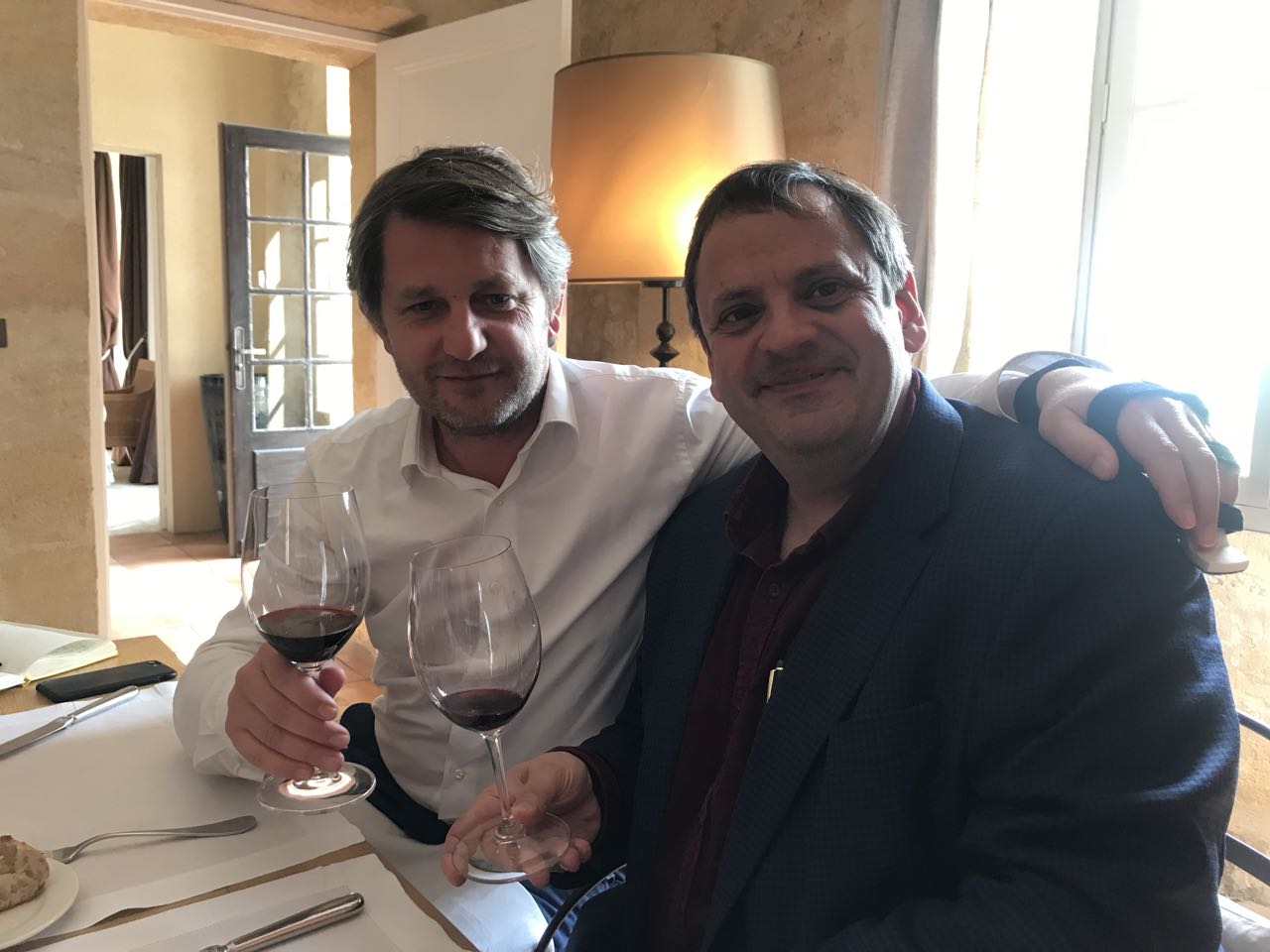
Lunch with Aymeric de Gironde of Château Troplong Mondot
Château Troplong Mondot – Tasted at the estate with recently named director Aymeric de Gironde. This was interesting in the sense that I wonder if the 2017 can rival the 2018! Yields – 49 hectoliters per hectare – were high and extractions low, so the pH here was but 3.56. Quite low indeed for the vintage. De Gironde stressed the challenges of the vintage, which he described as “harmony and balance coming from extremes”. This was not like 2005, “which was a textbook vintage, but rather two extremes that worked”. The alcohol clocks in at 14.5% and although de Gironde was “hoping for 14%” he said that the terroir at the estate is “a bit like a sugar machine that provides alcohol”. How is the wine? Well, it blends 85% Merlot, 13% Cabernet Sauvignon and 2% Cabernet Franc. If you like salinity and elegance, like I do, it is excellent! There is elegance and juiciness here. But I wonder whether the 2017 rivals the 2018 in terms of density and extract. In any case, more red than dark fruit and the finish is long and fresh. It is aging in 60 percent new oak, and that will add complexity (and “fill out” the palate) when the wine is bottled. 93-95+
Château Trottevieille – A very smooth expression, with ripe dark red fruit. There is balance and nuance to this wine. 92-94
Château Valandraud – A fine expression from the self proclaimed Bad Boy. I mean, here we have a hot and dry vintage, and I am thinking that this would be big. Nope. The nose has freshness, there is a pleasing Merlot sumptuousness, as expected, but not overdone. I do get a slight sense, still, of a touch of drying on the finish. Maybe to please older fans? In any case, bravo to the Thunevins for crafting an excellent wine! 92-94
Château Villemaurine – Even better than the Valandraud, tasted just beforehand? Maybe. I mean, the depth is more contestable between the two wines, but we have more freshness, with ripe and juicy fruit. Not the longest finish, but nice, refined tannin. Just 7 hectares of vines. Tasted twice, with similar results: Not heavy or hard. Sure, you have some heady aspects, but not overly inebriating. 92-95
Château Yon Figeac – The supple tannins are really appealing here, and I do not get a sense of heavy oaking; either aromatically or on the palate. The finish has lift. One of the best en primeur at this 24 hectare estate that I have experienced. Comparable to the Villemaurine. 91-94
 Wine Chronicles
Wine Chronicles
Share This